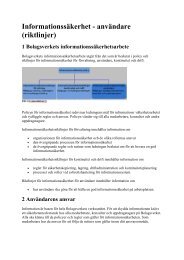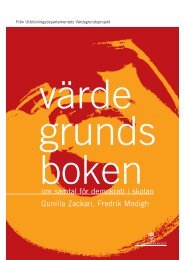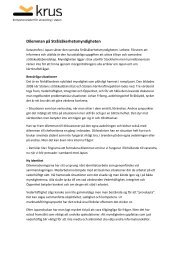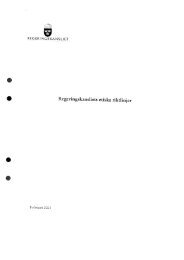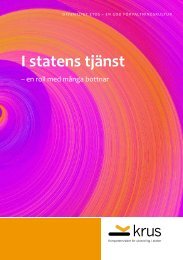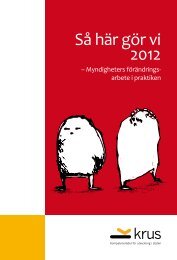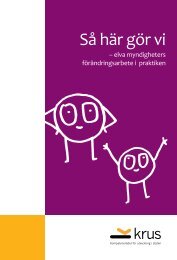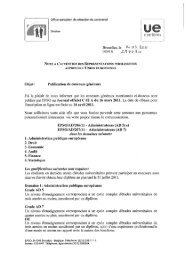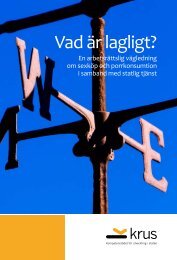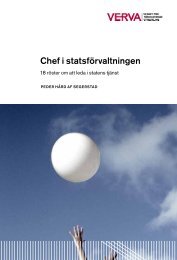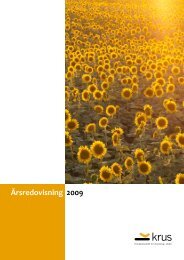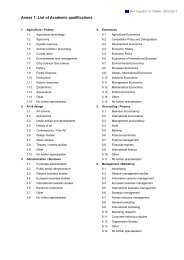Dialogkompetens i skolans vardag - Publikationer - LTU - Luleå ...
Dialogkompetens i skolans vardag - Publikationer - LTU - Luleå ...
Dialogkompetens i skolans vardag - Publikationer - LTU - Luleå ...
Create successful ePaper yourself
Turn your PDF publications into a flip-book with our unique Google optimized e-Paper software.
560 A.-C. Wennergren and K. Rönnerman<br />
owner of the question, which also implies taking responsibility for the action research<br />
process. In this case, the questions raised in shadowing formed the basis for the main<br />
development question formulated together with colleagues, which also gave the feeling<br />
of being involved in the process:<br />
The kick off gave me the feeling of creating the project together with my group. (Teacher C)<br />
As a practitioner I do feel like we own the question we have created. (Teacher D)<br />
All of the participants agreed that the opportunities for shadowing colleagues, and/or<br />
themselves being shadowed, increased understanding and led to a greater awareness<br />
of various classroom cultures. They described shadowing as an experience of mirroring<br />
their own classrooms. It also motivated and inspired participants to improve their<br />
own practice.<br />
The feeling I experienced is like studying myself [in the classroom] from a distance. The<br />
questions and reflections raised in someone else’s practice are actually meant for me.<br />
(Teacher G)<br />
The responses derived from the shadowing situations range from confirmations to<br />
challenges. Although the participants asked for challenges, as response-givers they<br />
provided little in terms of input during the first year. Later on, however, when analysing<br />
other participants’ responses, they realised that there was a gap between what they<br />
wanted to give, and what they actually gave to colleagues. For this reason, they asked<br />
each other, when giving feedback, for a balance between confirmations and challenges.<br />
Write the criticism in an understanding way and don’t forget the positive aspects. Ask<br />
questions of the teacher who is the focus of your shadowing. The negative criticisms and<br />
the confirmation should be in balance. (Teacher C)<br />
Positive responses in the form of confirmation may be looked upon as a strategy<br />
towards bolstering self-confidence and establishing a sense of mutual trust among the<br />
participants. Nevertheless, assessment must be specific. General praise, such as ‘fine’<br />
and ‘good’, is, according to classroom observations made by Dysthe (1993), seldom<br />
considered of any real value.<br />
It doesn’t give me anything when the response is indifferent or mediocre. When the shadowing<br />
teacher is critical it leads me to enter deeply into my reflections. (Teacher D)<br />
Neither excessively critical responses nor extremely hard challenges benefit the learning<br />
process, when bearing in mind that the purpose for the participants is to be one<br />
another’s critical friend in the ZPD. During a session focused on defining the role of<br />
a critical friend, the teachers stressed that in the beginning it was difficult to deal with<br />
challenges.<br />
You need support and confirmation to know if you have found a practical solution. When<br />
someone is shadowing me I ask for challenges, at first it is difficult to face, but it is a necessity<br />
from the perspective of improving practice. (Teacher G)<br />
Being in the role of the giver of a response involves a period of learning about how<br />
to use shadowing as a tool. Some participants found it easier to ask for responses than<br />
to give them to others.



